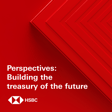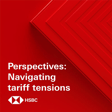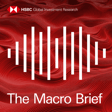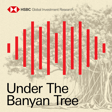Become a Creator today!Start creating today - Share your story with the world!
Start for free
00:00:00
00:00:01

The Macro Brief – Earnings learnings
Mark McDonald, Head of Data Science and Analytics, outlines what our AI-driven analysis of earnings call transcripts tells us about the key themes in this reporting season. Disclaimer: https://www.research.hsbc.com/R/101/MprXJBW. Stay connected and access free to view reports and videos from HSBC Global Research follow us on LinkedIn https://www.linkedin.com/feed/hashtag/hsbcresearch/ or click here: https://www.gbm.hsbc.com/insights/global-research.
Hosted on Acast. See acast.com/privacy for more information.
Transcript
Introduction to HSBC Global Viewpoint Podcast
00:00:02
Speaker
Welcome to HSBC Global Viewpoint, the podcast series that brings together business leaders and industry experts to explore the latest global insights, trends, and opportunities.
00:00:13
Speaker
Make sure you're subscribed to stay up to date with new episodes.
00:00:16
Speaker
Thanks for listening.
00:00:17
Speaker
And now onto today's show.
00:00:24
Speaker
This podcast was recorded for publication on the 21st of November 2024 by HSBC Global Research.
00:00:29
Speaker
All the disclosures and disclaimers associated with it must be viewed on the link attached to your media player.
00:00:34
Speaker
And please follow us on Apple and Spotify or wherever you get your podcasts.
00:00:37
Speaker
Just search for The Macrobrief.
Introduction to Podcast Topics with Pierre Spartel
00:00:42
Speaker
Hello, I'm Pierre Spartel in London and welcome to The Macrobrief.
00:00:45
Speaker
Rate cuts, China's stimulus, a strong dollar, and the threat of tariffs are just some of the issues facing the global economy.
00:00:53
Speaker
So as we head towards the end of the year, our data science team has been assessing the latest round of earnings calls to find out how companies are feeling about the future.
00:01:01
Speaker
Mark McDonald is head of data science and analytics, and he joins me here in the studio.
Mark McDonald on AI in Financial Analysis
00:01:06
Speaker
Mark, great to have you back.
00:01:07
Speaker
Thanks for having me on the podcast again.
00:01:08
Speaker
It's great to be here.
00:01:09
Speaker
And Mark, we have talked about this kind of data processing of earning statements.
00:01:14
Speaker
And you talked previously about natural language processing, which is kind of the tool that allows you to process all this information.
00:01:20
Speaker
But you've hidden in the appendix of your report one of the most interesting parts, which is that
00:01:24
Speaker
You're using AI to enhance NLP.
00:01:27
Speaker
How does that work and has that really saved you time?
00:01:29
Speaker
Yes, I say it really has.
00:01:31
Speaker
So often the process with the natural language processing is you've got to find the relevant sentences for a topic and then you've got to convert those sentences into data so you can analyze it in the normal way.
00:01:45
Speaker
And often each way that you want to turn the text into data, historically that would have meant building a custom machine learning model just for that task.
00:01:55
Speaker
And the only way to teach the machine learning model what the right answer was, was for humans, and sadly,
00:02:01
Speaker
often me and my team have to go through manually lots of sentences and say, ah, this one's relevant and this one's not, or this one's positive and this one's negative.
00:02:10
Speaker
And that's quite onerous, so it limits the enthusiasm for doing this, and it's time-consuming and expensive.
00:02:16
Speaker
Whereas the great thing about these modern powerful AI models such as GPT-4 is they've seen so much context as part of their training that they really do understand what you mean by various questions as long as you can explain them clearly enough.
00:02:32
Speaker
And so what we've done in this section that you're referring to is we've been looking at all the sentences where companies have been talking about risk, and then we've been asking the AI model to convert that into data along a variety of characteristics.
00:02:45
Speaker
So for example, is this sentence actually relevant about risk, or is it some generic, we have the risk of forward-looking statements kind of sentence?
00:02:53
Speaker
Is it about a risk that is improving or worsening or is it unclear?
00:02:57
Speaker
And we also asked it to assess which categories of risk are they really referring to.
00:03:03
Speaker
Historically, each of those aspects would have been a separate machine learning model that we'd have had to have built.
00:03:07
Speaker
Whereas as it was, all we had to do was write the prompt in English and then the AI tool can go off and do this for you.
00:03:14
Speaker
And so it's not just as a big efficiency upgrade, I think it's also a change in the way that these models can be used.
00:03:25
Speaker
because historically you needed a big data science team to do all of those tasks and now it becomes the business expert can just tell the machine what they want.
00:03:35
Speaker
So I think this is a very promising pathway for how companies can use AI generally and particularly in the world of financial market research.
00:03:44
Speaker
I suppose it comes back to something we discussed before, that AI can be seen as a threat or an opportunity, but in this case, it's kind of
Guidance Sentiment Indices Analysis
00:03:51
Speaker
like a symbiosis.
00:03:51
Speaker
You use AI to become even more efficient and your analysis becomes even more in-depth.
00:03:57
Speaker
Yes, absolutely.
00:03:59
Speaker
I think not only is it a symbiosis, but it also just opens up the possibility of doing new things.
00:04:07
Speaker
That analysis, probably we wouldn't have felt we had the time or the resource to really do it, so it would have just gone undone.
00:04:14
Speaker
Whereas now it becomes something extra that we can do.
00:04:16
Speaker
And I think this is the way to think about AI.
00:04:20
Speaker
It's not just a risk that it might come and replace human activity.
00:04:25
Speaker
With a growth mindset, you can look at this as like, well, this allows me to do so much more that previously was either impossible or wildly impractical.
00:04:34
Speaker
I hope the global head of research is listening to our conversation.
00:04:37
Speaker
Let's get to some of the results.
00:04:40
Speaker
So firstly, what you refer to as a GSI, the guidance sentiment indices, which is the processing all of this data gives you some sentiment indications.
00:04:53
Speaker
And interestingly, the overall sentiment seems positive and has been trending up, but there are some interesting regional divergences.
00:05:00
Speaker
Yes, that's true.
00:05:01
Speaker
So probably for the last year and a half, these guidance sentiment indicators, which really assess how positively or negatively companies are speaking about the future, when you aggregate this at country level, they've all been trending upwards.
00:05:14
Speaker
And so they're now, as I would say, objectively high levels, higher than pre-COVID, for instance.
00:05:20
Speaker
What's interesting in the most recent reporting season is that the US has continued to improve on this measure, whereas in the Eurozone we've seen this measure fall.
00:05:31
Speaker
And when we look by sector, you can see that in the US what we've seen is most sectors have improved on guidance sentiment with some notable improvements.
00:05:40
Speaker
Whereas in Europe, most sectors have probably got a little bit worse, with some notable worsening, particularly in sectors like industrials and materials.
Unusual Corporate Strategy Discussions in Earnings Reports
00:05:51
Speaker
And so this really suggests that European companies are speaking less positively about the future.
00:05:57
Speaker
Next, we come to the word maps.
00:05:59
Speaker
I love those.
00:05:59
Speaker
I'm very visual.
00:06:02
Speaker
And you did a couple which we should talk about.
00:06:04
Speaker
One is the trending terms in U.S. earnings reports.
00:06:09
Speaker
I mean, there are terms like hurricane, election, nuclear, administration, rate cut.
00:06:14
Speaker
What were the sort of conclusions coming out of that?
00:06:17
Speaker
Yeah, so with that analysis, what we're not looking for is which words are people using the most, because that's often not that informative.
00:06:25
Speaker
Often the same topics occur again and again in earnings calls, and that tends to dominate that type of analysis.
00:06:32
Speaker
What we're looking for here are things that are being used atypically frequently.
00:06:36
Speaker
So each of the terms that are being picked up with this, they're being used at least twice as frequently as normal.
00:06:41
Speaker
And sometimes this picks up themes that obviously it's clear why they're there, like hurricane, election, those are obvious.
00:06:49
Speaker
Sometimes it picks up things that are a bit more interesting.
00:06:51
Speaker
So you mentioned nuclear.
00:06:53
Speaker
There's been a real sea change in the attitude towards nuclear energy.
00:06:57
Speaker
I think some of this is really coming from the whole AI theme, the energy requirements needed to train these models and serve these models.
00:07:07
Speaker
is something that's a big issue for utilities companies.
00:07:10
Speaker
And so we're starting to see people really seriously discussing increasing nuclear energy with small modular reactors.
00:07:19
Speaker
And even some of the tech companies are discussing the prospect of building these nuclear reactors themselves to power their data centers.
00:07:27
Speaker
And actually, you're right.
00:07:28
Speaker
It's not surprising that you see the term, for example, hurricane.
00:07:32
Speaker
But then I did a double take because I thought this is actually in corporate earnings reports.
00:07:37
Speaker
So these are corporates actually looking at hurricanes maybe and thinking, actually, this is potentially affecting me because of the damages and what have you.
00:07:45
Speaker
So I guess that's interesting as well.
00:07:47
Speaker
Yes, you're seeing a lot of that discussion coming from, say, the insurance sector, where it does make a material difference to their reported results.
Global Outlook and Macro vs. Micro Data Insights
00:07:57
Speaker
The other one is, obviously, this is the time of the year, but you looked at global year ahead statements.
00:08:02
Speaker
What did the analysis show there?
00:08:04
Speaker
So there I would say it's mostly pretty positive.
00:08:08
Speaker
There are some fairly obvious big macro themes that are weighing on companies' minds.
00:08:13
Speaker
So the prospect for rate cuts, the prospects for the stimulus.
00:08:18
Speaker
But there's also some genuinely positive trending terms coming through there with companies talking about strong growth and strong cash flows and opportunities that they're seizing.
00:08:27
Speaker
The other thing that I thought was interesting about the analysis is this divergence between what corporates are saying about the general macro environment, and then you do this thing of looking at key financial terms where that seems to show much more positive reading about the outlook.
00:08:42
Speaker
Yes, exactly.
00:08:44
Speaker
Some macro data doesn't look that positive if you look at, say, PMIs and the ISM.
00:08:51
Speaker
They're not suggesting that positive an outlook.
00:08:54
Speaker
And so the positivity that we're picking up in guidance sentiment might seem a little surprising.
00:09:00
Speaker
If we look at the sentiment of company management when they speak about the macro environment, that has deteriorated this earnings season, as the companies are speaking more negatively when speaking about macro factors.
00:09:12
Speaker
However, if you look on the other side, it's not just the guidance sentiment that has been increasing.
00:09:17
Speaker
You've seen improvements in what we call key financial terms sentiment.
00:09:21
Speaker
And this is really a mixture of discussions of earnings and revenue and margins and guidance and other key factors directly relating to the operations of the company.
00:09:31
Speaker
And that continues to be very positive and increasingly so.
00:09:35
Speaker
And so this suggests an interesting tension.
00:09:38
Speaker
I would argue that company management probably don't have any superior insight into the broad macro environment, but they do have a superior insight into the operations of the companies that they're running.
00:09:50
Speaker
And so for me, if I had to pick one of those, I would say that positive signal coming from the key financial term sentiment is probably more significant.
00:09:57
Speaker
Yes, it does, and it's surprising in a way, but it's kind of a real grassroots indicator, isn't it?
00:10:02
Speaker
Absolutely.
00:10:03
Speaker
I think that's the benefit of this type of natural language processing analysis in that it allows you to look from this very micro data and try and aggregate a sort of macro signal.
Regional Differences in Tariff Concerns
00:10:13
Speaker
And you're entitled to report U.S. exceptionalism, and that really comes through when you look at the sort of reactions and statements to tariffs.
00:10:23
Speaker
Yes, I mean, it's not just on the guidance sentiment that we see a sort of difference between the U.S. and Europe.
00:10:30
Speaker
Tariffs is obviously a...
00:10:32
Speaker
a prospect that's also weighing on company management's mind, it appears in the trending terms.
00:10:38
Speaker
If we look by region and see where these discussions are focused, then they have ticked up.
00:10:46
Speaker
It wasn't really a factor until recently.
00:10:48
Speaker
They have ticked up, but they've ticked up much more notably in, say, Europe and Asia than they have in the US.
00:10:53
Speaker
I guess U.S. companies are less exposed to this risk.
00:10:57
Speaker
So it's another aspect that feeds into the U.S. exceptionalism.
00:11:01
Speaker
When we look by sector, it seems like the big pickup has been in consumer discretionary, particularly autos and the supply chain associated with that.
00:11:11
Speaker
A treasure trove of interesting data, as ever, when we talk to you.
00:11:16
Speaker
Mark, thank you very much for today's comments.
00:11:18
Speaker
Thanks for having me on the show.
Investment Themes and Strategic Opportunities Discussion
00:11:23
Speaker
Three points on which to end this week's macro brief.
00:11:26
Speaker
Here at HSBC Research, we view the world through the lens of nine key investment themes.
00:11:31
Speaker
But while our themes are very much skewed to the longer term, investors frequently ask us how they can be used to find value today.
00:11:39
Speaker
So our strategists, Amit Srivastava and Edward Stanford, have launched a new radar tool which helps identify which are the most and least attractive themes now from an equity strategy perspective.
00:11:51
Speaker
After a period of stock market gains in India alongside impressive GDP growth, recent data releases have given mixed messages.
00:11:59
Speaker
So to get a clean read on the state of the economy, Pranjal Bhandari, chief India economist, has brought together 100 indicators of growth and mapped them to various sectors.
00:12:09
Speaker
If you'd like to know more, check out the latest edition of our sister podcast, Under the Banyan Tree, where Pranjal discusses her key findings.
00:12:18
Speaker
And finally, staying in Asia, a reminder that the Extel Asia Survey 2025 is underway.
00:12:24
Speaker
If you are an HSBC client participating in the survey and you value our service and insight, this is a reminder to you, please vote.
00:12:33
Speaker
The survey is already open and runs until the 6th of December.
Podcast Conclusion and Closing Remarks
00:12:38
Speaker
So that's it from us.
00:12:39
Speaker
If you've got any comments or questions, please contact us at askresearch at hsbc.com.
00:12:45
Speaker
And if you haven't done so already, please follow the macro brief on Apple and Spotify or wherever you get your podcasts.
00:12:52
Speaker
Thanks for listening, and we'll be back next week.
00:13:19
Speaker
Thank you for joining us at HSBC Global Viewpoint.
00:13:22
Speaker
We hope you enjoyed the discussion.
00:13:24
Speaker
Make sure you're subscribed to stay up to date with new episodes.
















